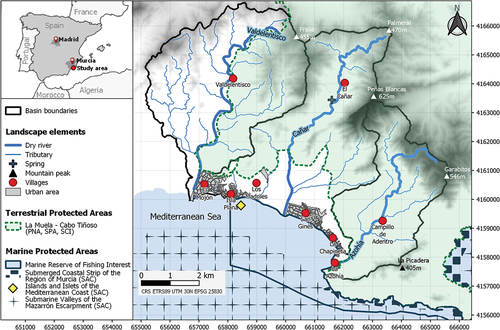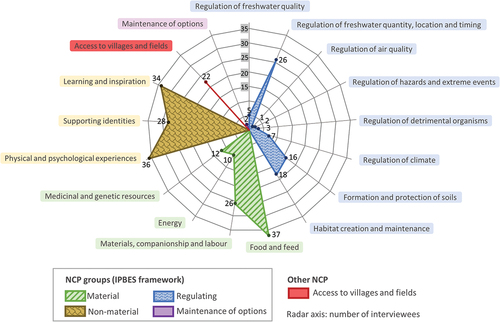Figures & data
Figure 1. Location of the region of Murcia in south-eastern Spain and map of the study area. The black line delimits the study basins: Valdelentisco, El Cañar and La Azohía. The thick blue lines are the dry rivers and the thin blue lines are their tributaries. The triangles are the highest mountain peaks. The blue cross is a small flood-dependent spring. The red circles are the villages. The grey rectangles are urban areas. Terrestrial and marine protected areas are represented with different symbols. PNA = protected natural area; SPA = special protection area; SCI = site of community importance; SAC = special area of conservation; CRS = coordinate reference system.

Figure 2. Nature’s contributions to people (NCP) provided by dry rivers as reported by interviewees. NCP are classified according to the categories proposed by the generalising perspective of the IPBES conceptual framework. A category of NCP not included in the previous framework is also applied: access to villages and fields. The number of interviewees that reported each NCP category is indicated.

Table 1. Material nature’s contributions to people (NCP) provided by dry rivers, as reported by interviewees. Material NCP are classified by applying the categories proposed by the generalising perspective of the intergovernmental science-policy platform on biodiversity and ecosystem services (IPBES) conceptual framework (Díaz et al. Citation2018). The number of interviewees (Ni) and social groups (Ng) reporting each NCP category are indicated. The NCP categories are exemplified by verbatim quotes from the interviewees.
Table 2. Non-material nature’s contributions to people (NCP) provided by dry rivers, as reported by interviewees. Non-material NCP are classified by applying the categories proposed by the generalising perspective of the intergovernmental science-policy platform on biodiversity and ecosystem services (IPBES) conceptual framework (Díaz et al. Citation2018). The number of interviewees (Ni) and social groups (Ng) reporting each NCP category are indicated. The NCP categories are exemplified by verbatim quotes from the interviewees.
Table 3. Regulating nature’s contributions to people (NCP) provided by dry rivers, as reported by interviewees. Regulating NCP are classified by applying the categories proposed by the generalising perspective of the intergovernmental science-policy platform on biodiversity and ecosystem services (IPBES) conceptual framework (Díaz et al. Citation2018). The number of interviewees (Ni) and social groups (Ng) reporting each NCP category are indicated. The NCP categories are exemplified by verbatim quotes from the interviewees.
Figure 3. Synergies and trade-offs between the nature’s contributions to people (NCP) provided by dry rivers. NCP are classified according to the categories proposed by the generalising perspective of the IPBES conceptual framework. A category of NCP not included in the previous framework is also applied: access to villages and fields. Each line indicates the interaction between two NCP categories. The thickness of the line indicates the number of interviewees who reported an interaction (the thicker the line, the more interviewees). The interactions reported by more than five interviewees are shown numerically. Synergies are represented with grey lines and trade-offs with red lines.

Table 4. Synergies between nature’s contributions to people (NCP) in dry rivers most reported by interviewees. NCP are classified by applying the categories proposed by the generalising perspective of the intergovernmental science-policy platform on biodiversity and ecosystem services (IPBES) conceptual framework (Díaz et al. Citation2018). The NCP A either supports or increases the NCP B. The number of interviewees (Ni) and social groups (Ng) reporting each synergy are indicated, as well as examples based on verbatim quotes from the interviewees.
Table 5. Trade-offs between nature’s contributions to people (NCP) in dry rivers most reported by interviewees. NCP are classified by applying the categories proposed by the generalising perspective of the intergovernmental science-policy platform on biodiversity and ecosystem services (IPBES) conceptual framework (Díaz et al. Citation2018). The NCP A decreases the NCP B. The number of interviewees (Ni) and social groups (Ng) reporting each trade-off are indicated, as well as examples based on verbatim quotes from the interviewees.
